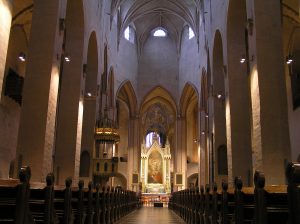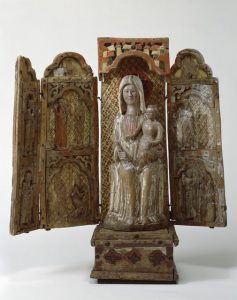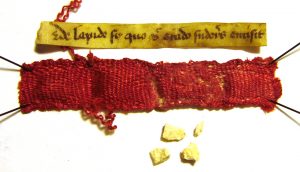The Reformation was not a very rapid process in Finland. Changes to the life of the Church were made gradually. Some changes were completed only decades or even centuries after the Reformation had started. Mental attitudes in particular likely changed very slowly.
The Finnish lay people probably first heard about the Reformation not in Finland, but in the Hanseatic cities of Tallinn or Gdansk, places they visited on a regular basis. They also had close contacts to other cities on the shores of the Baltic Sea. Both Gdansk and Tallinn were reformed as early as the early 1520s, and it is quite probable that Finnish people witnessed and maybe even participated in the reformatory uprisings in those cities.
Finnish people thus had already at least heard of the events of Reformation when it started officially in the Swedish realm in 1527. Even so, the Reformation did not alter the Finnish culture and society very quickly. The

Inside of the Cathedral of Turku. The Cathedral interior was greatly changed during the Reformation. The Church suffered badly in the 1827 Great Fire of Turku, and the interior was subsequently completely renewed. Janne Tunturi.
first visible change was the appropriation of the greater part of the Church’s valuable articles such as reliquaries, metal crosses and other items made of precious metals by the Crown. This reduced the splendour of the churches, thus probably affecting also the mental image of the Church.
The Crown also transferred two thirds of the Church’s income to itself. This affected the ability of the parishes to build new church buildings or even repair the existing ones. Virtually no new churches were built during the entire 16th century. Turku Cathedral was soon in such a very poor condition that the newly appointed Bishop of Turku, Isaacus Rothovius, complained in 1627 that even the roof of the Church was completely broken, and that it snowed inside the Church during winter.
The liturgy was altered following the principles of the Reformation. Vernacular language was used for the entire

A very well preserved medieval statue of Saint Anna, Madonna and Child, transformed into a Madonna and Child statue probably after the Reformation. CC BY 4.0, The National Museum of Finland
Mass. Rituals considered Catholic and prayers addressed to saints or to the Virgin Mary were gradually given up. Holy water, anointing oil and sanctified salt were no longer used. The side-altars were not supposed to be used anymore, but the change was very slow in this respect, too, as in the 17th century Bishop Rothovius had to take measures to eradicate the usage of the side-altars from his cathedral.
All in all, the first century after the Reformation seems to have been more a period of a slow decline. Only after 1627 did the Reformation start to create new structures for the Church. The church as a public space was now to manifest the Lutheran orthodox doctrine and the social hierarchy. New pews were made for the churches, strictly organised in a hierarchical order. Every person had their own place according to his or her social status. New pulpits were also made to emphasise the central role of the sermon in Lutheran liturgy.
Iconoclasm in Finland
Statue of Madonne and Child, with its nose cut off and Child removed. CC BY 4.0, The National Museum of Finland.
There is no written evidence of iconoclasm in Finland, and a comparatively high number of medieval statues of saints have been preserved. However, the statues were not left untouched. Instead, they were probably removed from the cabinets in which they were standing, and their aura of sanctity was thus lessened. Statues were also deprived of jewellery or crowns made of precious metals when the King took possession of the Church’s valuables.
There are some signs of possible iconoclasm, as the noses of many statues are broken, as if they had been cut off. In any case, the statues were modified, re-used or left to decay in the centuries following Reformation. When it comes to the painted fresco murals, they were largely left intact in the 16th century, but in some Churches they were subsequently covered much later, in the 18th and 19th centuries.
The relics of Turku Cathedral
After the Reformation, relics of saints lost their significance as holy objects and they were no longer venerated. There were, however, no clear directions concerning what should be done with the relics after the Reformation. In the Turku Cathedral, some of the relics
The stones from Gethsemane, one of the remaining relics from the Cathedral of Turku. Aki Arponen.
were kept in the back room of the sacristy, sheltered from the numerous fires that ravaged the Cathedral. The relics include a fragment of bone attributed to Saint Pancratius, stones from Gethsemane, and a skull and two forearm bones reputed to be relics of Saint Henry, the patron Saint of Finland. Thus, it seems that the relics were in some way seen as important even after the Reformation, despite no longer being venerated.


Leave a Reply